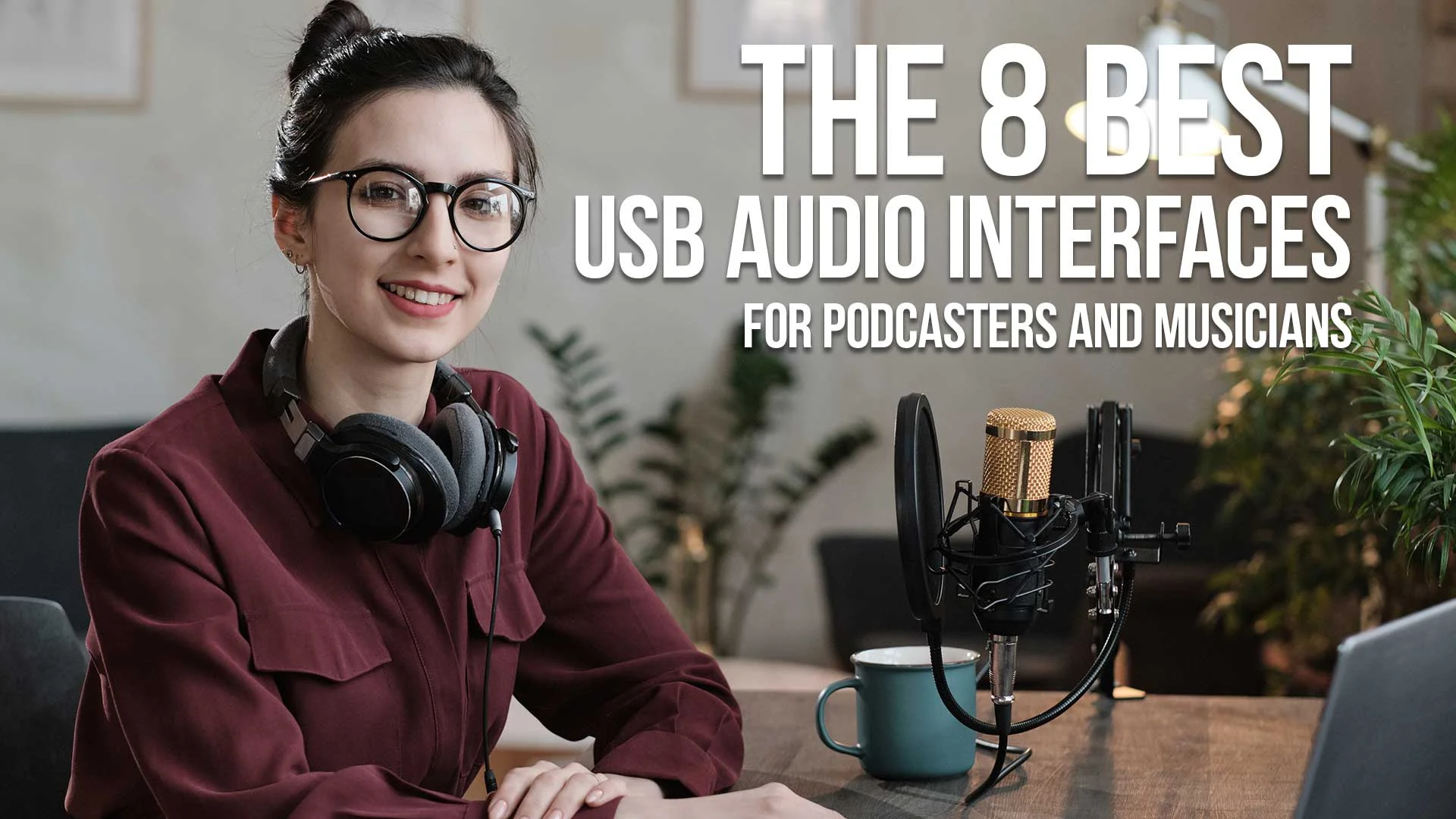Are you looking for the best USB audio interface to use in your home studio?
Or are you looking to step up the current sound quality of your podcast?
If so, you’ve come to the right place.
In this post, we will discuss the best USB interfaces on the market and how to choose the one that is best for your needs.
We will also take a look at the pros and cons of each top notch interface.
So, whether you are a beginner or an experienced musician or podcaster, read on to learn more about some popular USB interfaces available today.
Table of Contents
- The Best USB Audio Interfaces For Home Studios And Podcasters
- Focusrite Scarlett 2I2 3Rd Gen USB Interface
- Universal Audio Volt 2 USB Interface
- RME Fireface 802 USB Interface
- Native Instruments Komplete Audio 6 USB Interface
- MOTU M6 6X4 USB-C Audio
- Focusrite Vocaster Two USB Interface
- Audient EVO 4 USB Interface
- M-Audio AIR 192X6 USB C Interface
- USB Audio Interfaces: What Are They And What Do They Do?
- What Is A USB Audio Interface?
- What Does A USB Audio Interface Do?
- Benefits Of Using A USB Audio Interface
- Types Of USB Audio Interfaces
- How To Choose The Right USB Audio Interface

The Best USB Audio Interfaces for Home Studios and Podcasters
So, what are some of the best USB interfaces on the market today?
Here are eight of our top picks:
- Focusrite Scarlett 2i2 3rd Gen USB Interface
- Universal Audio Volt 2
- RME Fireface 802 USB Interface
- Native Instruments Komplete Audio 6 USB Interface
- MOTU M6 6x4 USB-C Interface
- Focusrite Vocaster Two
- Audient EVO 4
- M-Audio AIR 192x6 USB C Interface
Whether you are looking for high-quality sound, connectivity options, or affordability, there are USB interfaces that are perfect for your home studio needs.
I include links to purchase the units on Amazon and/or Best Buy.
Or go down to your local music store and check them out!
Let's dig in to the features and price of each model in this review.
Focusrite Scarlett 2i2 3rd Gen USB Interface
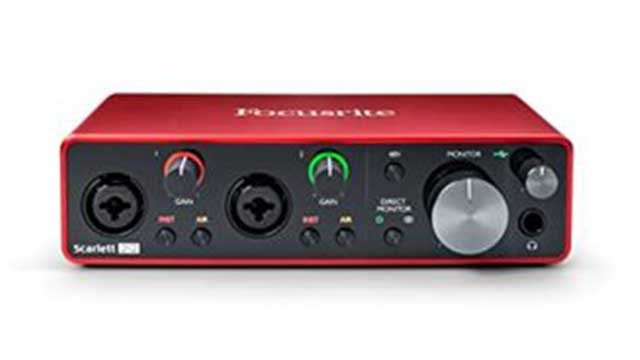
Features:
- 24-bit/192kHz audio resolution
- 2 x combo inputs with Scarlett mic preamps, line level and instrument inputs
- Class-leading conversion and sample rates up to 192kHz/24 bit
- Compact form factor for easy portability
- Includes Cubase LE DAW software for recording and editing audio
Price:
At around $150, the Focusrite Scarlett 2i2 3rd Gen is one of the best options for home studio musicians who are on a tight budget.
It offers professional quality audio at an affordable price, making it one of the best USB interfaces available today.
This is the model that I use for voiceover and music production.
Joseph's Review of the Focusrite Scarlet:
This is the current USB audio interface I'm using for voiceover and music production. It's got a great build and superior audio quality. I'm super happy with it, whether I'm recording voice or acoustic instruments with my Neumann mic or directly plugging my electric guitar or synth into it, I've been very happy with it for years.
Plus it's red and looks rad! 🔥
Get the Best Price for the Focusrite Scarlett 2i2 3rd Gen at Amazon
Get the Best Price for the Focusrite Scarlett 2i2 3rd Gen at Best Buy
Universal Audio Volt 2 USB Interface
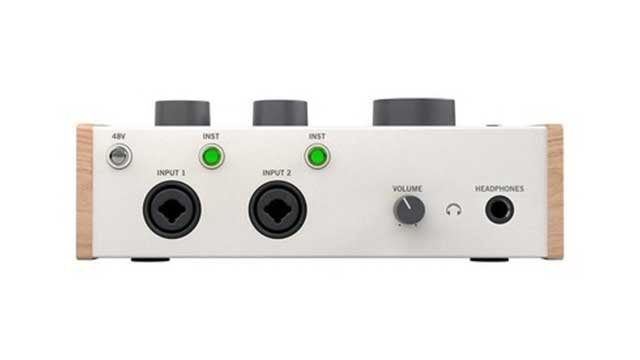
Features:
- 2 x combo inputs with UAD-2 QUAD Core processing
- Class-leading preamp technology and high-quality audio conversion
- Built-in DSP allows for transparent realtime tracking and easy mixing with zero latency
Price:
The Universal Audio Volt 2 is one of the most powerful and versatile USB interfaces on the market today.
With 2 x combo inputs, built-in UAD quad core processing, and advanced preamps, it offers incredible quality audio and flexibility at a price starting around $169.
The Universal Audio brand name represents classic, high-quality preamps.
Get the Best Price for the Universal Audio Volt 2 at Amazon
RME Fireface 802 USB Interface
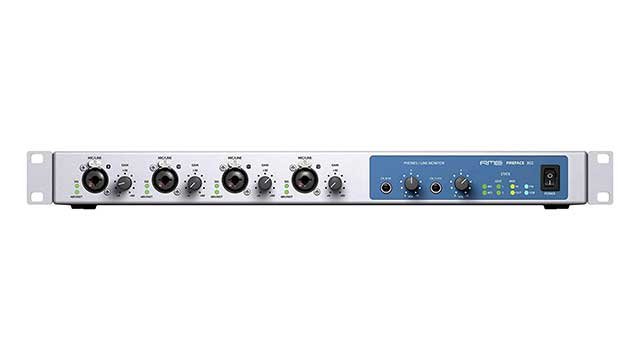
Features:
- 24-bit/192kHz analog to digital and digital to analog conversion
- Class-leading low latency performance for recording, mixing, and monitoring
- Fully customizable headphone output that allows you to control the level and routing of multiple stereo signals
- Durable all-metal construction with optional protective carrying case available
Price:
The RME Fireface 802 USB interface is one of the best options for experienced musicians who need a high-quality audio experience.
With 24-bit/192kHz AD conversion, low latency drivers, and advanced customization features, it offers professional audio quality and incredible flexibility at a price starting around $2000.
Get the Best Price for the RME Fireface 802 at Amazon
Native Instruments Komplete Audio 6 USB Interface
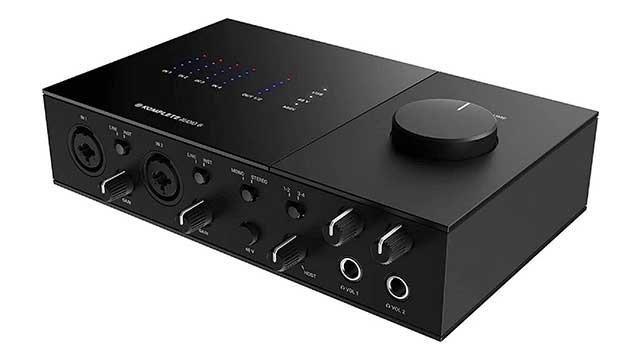
Features:
- 4 x analog inputs and outputs, 1 x headphone output
- Premium Class A mic preamps with phantom power for use with a wide range of studio mics and dynamic microphones
- Low latency performance, allowing you to monitor while recording without any distracting delays or dropouts
- Includes Steinberg Cubase LE DAW software for easy recording and editing of your audio projects
Price:
At around $200, the Native Instruments Komplete Audio 6 is one of the best options for musicians on a budget who are looking for high-quality home studio gear.
With premium Class A mic preamps, low latency drivers, and Steinberg Cubase LE software included, it offers powerful audio quality and functionality at an affordable price.
Get the Best Price for the Native Instruments Komplete Audio 6 at Amazon
MOTU M6 6x4 USB-C Audio
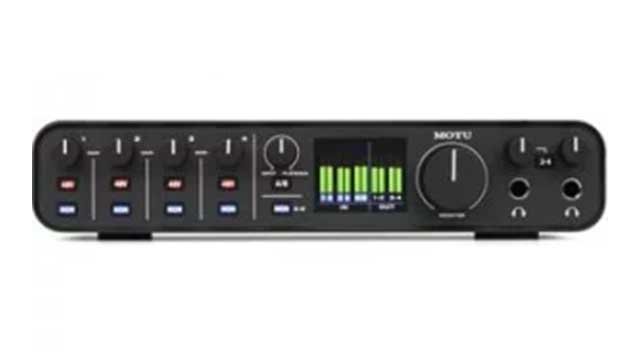
Features:
- 6 x high-quality audio inputs and outputs with 24-bit/192kHz AD conversion for exceptional sound quality
- Low latency performance allows you to monitor your recordings in real time while still capturing audio accurately and without any dropouts or delays
- Rugged all-metal construction with optional protective carrying case for use on the go or at home in your studio
Price:
At around $400, the MOTU M6 is one of the best options for musicians who want powerful audio functionality at a great price.
With its 6x4 interface, low latency drivers, and rugged all-metal design, it offers professional quality audio and portability at an affordable cost.
Get the Best Price for the MOTU M6 at Amazon
Focusrite Vocaster Two USB Interface
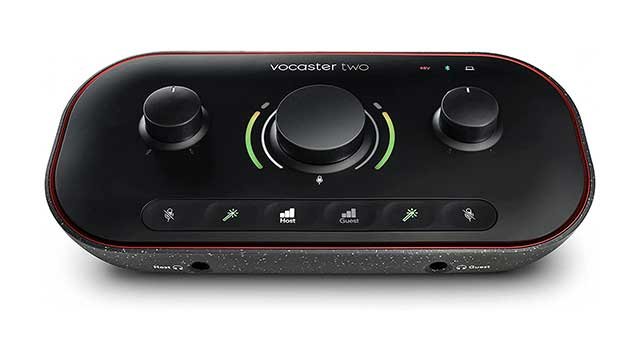
Features:
- 2 x high-quality microphone input channels with 48V phantom power, gain controls, and potentiometers for precise adjustment of audio levels
- Low latency performance allows you to monitor your recordings in real time while still capturing audio accurately and without any dropouts or delays
- Rugged metal construction for long-lasting durability in a variety of environments and conditions
Price:
At around $300, the Focusrite Vocaster Two is one of the best options for musicians who want powerful performance features at an affordable price.
With its dual mic inputs, low latency drivers, and rugged all-metal design, it offers advanced sound quality and functionality that will meet the needs of even the most demanding users.
Get the Best Price for the Focusrite Vocaster at Amazon
Get the Best Price for the Focusrite Vocaster at Best Buy
Audient EVO 4 USB Interface
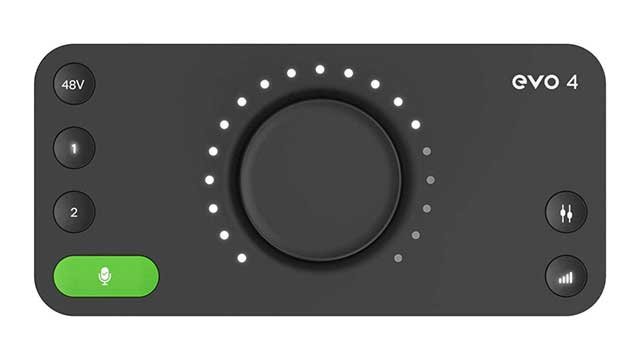
Features:
- 4 x high-quality audio inputs and outputs with 24-bit/192kHz AD conversion for exceptional sound quality
- Low latency performance allows you to monitor your recordings in real time while still capturing audio accurately and without any dropouts or delays
- Built-in compressor and limiter on the main output for increased control over your sound
Price:
At around $129, the Audient EVO 4 is one of the best options for musicians who want a professional interface that offers optimal flexibility and performance.
With its advanced features like low latency drivers, built-in compression and limiting, and 24-bit/192kHz AD conversion, it is an excellent choice for musicians of all levels who want to take their music to the next level.
Get the Best Price for the Audient EVO 4 at Amazon
M-Audio AIR 192x6 USB C Interface
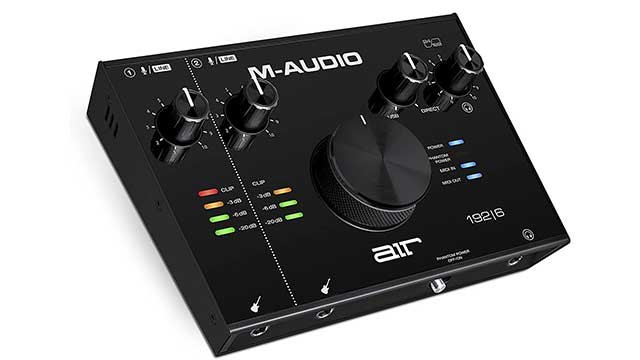
Features:
- 6 x high-quality audio inputs and outputs for exceptional sound quality and recording performance
- Low latency drivers allow you to monitor your recordings in real time, without any dropouts or delays
- Rugged metal construction for durability in a variety of environments and conditions
Price:
At around $169, the M Audio AIR is one of the best options for musicians who want a powerful and versatile interface that can keep up with even the most demanding recording needs.
With its 6x4 audio inputs and outputs, low latency drivers, and rugged all-metal design, it offers advanced functionality and performance that make it the ideal choice for any musician looking to take their music to the next level.
Get the Best Price for the M-Audio AIR at Amazon

USB Audio Interfaces: What Are They and What Do They Do?
The world of music production and recording is always evolving, and with the advent of digital technology, it has become easier than ever to capture and produce high-quality audio from the comfort of your own home.
One of the key pieces of equipment that has made this possible is the USB audio interface.
But what exactly is a USB audio interface and what does it do?
In this article, we will explore the world of USB audio interfaces, what they are, what they do, and how they can help you produce and record high-quality audio from your own home.
What is a USB Audio Interface?
A USB audio interface is a device that connects to your computer or laptop via the USB port via a USB cable and allows you to record, produce, and play back audio.
It essentially acts as an interface between your computer and your musical instruments or other audio sources.
The USB audio interface is an external device that is connected to your computer via a USB cable.
It typically includes inputs for microphones, instruments, and other audio sources, as well as outputs for speakers and headphones.

What Does a USB Audio Interface Do?
The main function of a USB audio interface is to convert analog audio signals into digital signals that can be processed by your computer.
This allows you to record, produce, and play back audio using your computer, without the need for additional equipment such as mixers, preamps, and analog-to-digital converters.
In addition to converting analog signals into digital signals, a USB audio interface can also improve the quality of your audio by providing high-quality preamps and other processing tools.
This can help you achieve professional-quality audio recordings and productions, even if you are working from your home studio.
Benefits of Using a USB Audio Interface
There are many benefits to using a USB audio interface in your home studio. Here are some of the key benefits:
- Improved Audio Quality: By providing high-quality preamps and processing tools, a USB audio interface can help you achieve professional-quality audio recordings and productions.
- Convenience: The USB audio interface is an external device that connects to your computer via a USB cable, which makes it easy to use and set up. You can also easily connect multiple audio sources to the device, such as microphones, instruments, and other audio equipment.
- Cost Effective: By providing a comprehensive solution for recording, producing, and playing back audio, a USB audio interface can save you money compared to purchasing separate pieces of equipment for each task.
- Portability: Many USB audio interfaces are compact and portable, making it easy to take your home studio with you wherever you go.
Types of USB Audio Interfaces
There are many different types of USB audio interfaces on the market, each with its own unique features and specifications. Here are some of the most common types of USB audio interfaces:
- Desktop USB Audio Interfaces: Desktop USB audio interfaces are larger and more feature-rich than their portable counterparts. They typically include multiple inputs and outputs, as well as high-quality preamps and processing tools.
- Portable USB Audio Interfaces: Portable USB audio interfaces are designed for on-the-go recording and production. They are compact and lightweight, making it easy to take your home studio with you wherever you go.
- Micro USB Audio Interfaces: Micro USB audio interfaces are designed for use with laptops and other mobile devices. They are compact and portable, and typically include only a few inputs and outputs.
- Multi-Channel USB Audio Interfaces: Multi-channel USB audio interfaces are designed for more complex recording and production setups. They typically have multiple inputs and outputs, allowing you to record and produce multiple audio tracks at once. These types of interfaces are ideal for musicians and producers who need to record a full band or orchestra.
How to Choose the Right USB Audio Interface
When choosing a USB audio interface, there are several factors to consider, including:
- Number of Inputs and Outputs: Depending on your recording and production needs, you may require more or fewer inputs and outputs. Make sure to choose a USB audio interface that has the right number of inputs and outputs for your setup.
- Quality of Preamps: The quality of the preamps in your USB audio interface can greatly impact the quality of your recordings. Make sure to choose a USB audio interface with high-quality preamps to ensure the best possible audio quality.
- Compatibility: Make sure to choose a USB audio interface that is compatible with your computer or laptop. Some interfaces may require specific operating systems or hardware, so be sure to check the compatibility before purchasing.
- Portability: If you need to take your home studio with you on the go, consider choosing a portable USB audio interface. These types of interfaces are compact and lightweight, making them easy to transport and set up wherever you go.
- Budget: USB audio interfaces come in a wide range of prices, from budget-friendly options to high-end professional interfaces. Determine your budget before choosing a USB audio interface, and make sure to choose one that provides the best value for your money.

USB Audio Interfaces Frequently Asked Questions
How Many Headphone Outputs Do I Need?
When choosing a USB audio interface, one of the most important factors to consider is the number of headphone outputs you need. Typically, interfaces with more headphone outputs are best suited for professional musicians and music producers who work in larger studio environments, while interfaces with fewer or single headphone outputs may be better suited for solo musicians and hobbyists who do not need as many monitoring options. Other things to consider when choosing an audio interface include its overall sound quality, latency performance, and compatibility with different recording software and computer systems.
What Is Latency Performance?
Latency performance refers to the amount of time between when you play a note on your instrument or record a vocal take and when that sound actually reaches your headphones or speakers. In general, audio interfaces with lower latency performance are best suited for musicians who need to monitor their recordings in real time and respond quickly to changes in the recording. Factors that can affect latency performance include the type of computer system you use, your audio interface's driver software, and its overall design and construction.
How Do I Choose an Audio Interface That Is Compatible With My Computer System?
When choosing a USB audio interface, one of the most important factors to consider is whether or not it is compatible with your computer system. Different audio interfaces will work best with different types of computers and operating systems, so it is crucial to do your research ahead of time to ensure that the interface you choose will work flawlessly with the equipment you already have. Some other factors to consider include the interface's software requirements and whether or not it is compatible with your favorite recording software, such as Garageband or Pro Tools.
In choosing a USB audio interface, there are many different factors to consider in order to ensure that you get the best performance possible. Whether you need multiple headphone outputs for large studio recordings, low latency performance for real-time monitoring, or compatibility with your computer system and recording software of choice, there is an audio interface out there that will meet your needs and help take your music to the next level.
What is the Difference Between Mic Inputs and Line Inputs?
One of the key differences between mic inputs and line inputs on a USB audio interface is that mic inputs are typically designed to handle significantly higher input voltages than line inputs. This allows you to connect microphones with large diaphragms or other high-sensitivity devices, while also ensuring that there is no risk of distortion from excess voltage. In addition, many USB audio interfaces feature built-in preamps or instrument amps for added flexibility when recording vocals or instruments. Overall, whether you need mic inputs or line inputs will depend on your specific recording needs and preferences, so it is best to do some research ahead of time in order to find an audio interface that meets all of your requirements.
Do the Best USB Audio Interfaces Have An Instrument Input?
While not all USB audio interfaces have an instrument input, many of the best options on the market do include this feature. In general, having an integrated instrument input can be very useful for musicians and producers who want to record multiple instruments or vocals at once without needing to use additional hardware or software. If you are looking for a USB audio interface that has high-quality mic inputs and instrument inputs, as well as low latency performance and a wide range of other features, there are many great options out there to meet your needs. So be sure to do your research ahead of time and find the best USB audio interface for you!
What are Digital Inputs?
Digital inputs, also known as AES or S/PDIF inputs, are input ports that allow you to connect external audio sources to your USB audio interface via a digital signal. This can be useful for connecting digital devices such as synthesizers and electronic drums, or for recording from equipment like mixing consoles and sound cards. While not all USB audio interfaces will include digital inputs, those that do typically offer higher quality recording performance due to their direct connection with the source material.
Which USB Audio Interfaces Have a MIDI Interface?
A USB audio interface with a MIDI interface can be a valuable tool for musicians and producers who need to control external hardware or software instruments via digital messages. While not all USB audio interfaces have this feature, many of the best options on the market do include a MIDI input, which allows you to connect keyboards, drum machines, and other external devices using a standard 5-pin DIN connector.
What is a MIDI Interface?
A MIDI interface, or Musical Instrument Digital Interface, is a type of input port that allows you to connect keyboards, drum machines, and other digital devices to your USB audio interface. This can be useful for controlling external hardware or software instruments via digital messages, as well as for sending data back and forth between different devices via MIDI connectors. While not all USB audio interfaces have this feature, those that do typically offer higher recording performance due to their direct connection with the source material.
Which USB Audio Interfaces Have Two Headphone Outputs?
If you are looking for a USB audio interface that is suitable for recording multiple performers at once, then one with two headphone outputs may be the best option for you. Many of the best options on the market include this feature, as it allows you to easily set up a monitoring system that lets each performer hear their own mix. This can be especially useful if you work in a professional recording studio or need to record multiple musicians and singers simultaneously during recording sessions, as it ensures that everyone hears exactly what they need in order to perform at their best. So be sure to do your research ahead of time in order to find the best USB audio interface with two headphone outputs for your specific needs.
Can I Use Drum Machines With my USB Audio Interface?
If you are looking for a USB audio interface that can be used with drum machines during the recording process, then there are many different options out there to choose from. Many high-quality audio interfaces include digital inputs or MIDI interfaces that allow you to connect these devices directly to your computer, so you should be able to find one that meets your needs regardless of what type of equipment you typically use in your music production setup. So do some research ahead of time in order to find the best USB audio interface for connecting your drum machine or other devices with ease.
What is Zero Latency Monitoring?
Zero latency monitoring, also sometimes referred to as direct monitoring or zero downtime monitoring, is a feature that is commonly found in USB audio interfaces. This allows you to hear exactly what you are recording with no delay, so there is no need to worry about changes in the source material affecting your mix later on. This can be especially useful for musicians and producers who need to record their performances live, as well as for those who work in professional recording studios
What Are Dynamic Mics?
A dynamic mic, or dynamic microphone, is a type of recording device that is widely used in both professional and personal music production setups. This type of microphone uses a small diaphragm to capture sound from sources near the mic and convert it into electrical impulses that can be amplified by your USB audio interface. Many popular models are known for their high-quality sound reproduction, user-friendly design, and long-lasting durability.
What Are Condenser Mics?
A condenser mic, or condenser microphone, is another type of recording device that can be used with a USB audio interface. Unlike dynamic microphones, which use diaphragms to capture sound via magnetic induction, condenser mics use piezoelectric plates to convert vibrations into electrical impulses. This makes them ideal for capturing audio from sources that are further away or require more sensitivity, such as recording vocals and acoustic instruments. However, they typically require external power in order to operate, so it is important to make sure that your USB audio interface has this feature if you plan to use a condenser mic with it.
What is Phantom Power?
Phantom power, also sometimes referred to as plug-in power or phantom voltage, is a type of external electrical current that can be used to power certain types of recording devices. This includes both condenser microphones and certain models of dynamic mics, so it is important to make sure that your USB audio interface has this feature if you plan to use a condenser or dynamic mic with it. Typically, phantom power can be activated through your audio interface's settings or via a switch on the device itself, and most modern USB interfaces will support this feature.
What is a Mic Preamp?
A mic preamp, or microphone preamplifier, is a type of circuit that is commonly found in audio recording equipment and USB audio interfaces. This device amplifies the voltage of incoming signals so they can be more easily converted into electrical impulses by your computer. Depending on the specific design of your USB audio interface, you may also have access to additional controls and settings for your mic preamp, such as gain or impedance adjustment.
What is Direct Monitoring?
Direct monitoring, also sometimes referred to as no-latency monitoring, is a feature that is commonly found in USB audio interfaces. This allows you to hear exactly what you are recording with no delay, so there is no need to worry about changes in the source material affecting your mix later on. This can be especially useful for musicians and producers who need to record their performances live, as well as for those who work in professional recording studios.
What is I/O?
"I/O" stands for input/output, which refers to the flow of data in and out of a device. In the context of USB audio interfaces, I/O refers to the number and types of inputs and outputs available for connecting microphones, instruments, speakers, headphones, and other audio equipment. A higher number of inputs and outputs can provide greater flexibility for recording and mixing audio.
When shopping for a USB audio interface, it's important to consider the I/O capabilities, such as the number of inputs, the type of inputs (e.g. XLR, 1/4" TRS, or instrument-level), and the number of outputs. This will help you determine the best audio interface for your needs, whether you're a podcaster recording a single microphone or a musician needing to record multiple instruments.
What Kind of Power Supply Does a USB Hub Use?
USB audio hubs typically use a USB connection or Thunderbolt 3 for power supply. Some devices may require an external power supply if they have higher power requirements. It's important to check the specifications of the audio interface to determine its power requirements and ensure that you have the proper setup for use.
What is USB C?
USB C is a type of USB (Universal Serial Bus) connector. It's a smaller, reversible plug that can be used for data transfer, charging devices, and audio/video transmission. The USB-C standard has replaced traditional USB connectors and is widely used on devices such as laptops, smartphones, and audio interfaces for its versatility and high data transfer speeds.
What Are USB Microphones?
A USB microphone is a type of digital microphone that connects to a computer or other digital device via a USB port. They are commonly used for recording audio for podcasts, live streaming, video conferencing, and other applications where high-quality audio is desired. They are popular due to their ease of use and compatibility with most computers, laptops, and other devices.
Can I plug my Guitar Amp into a USB Interface?
Yes, you can plug your guitar amp into a USB interface, but you will need a specific type of interface that is designed for this purpose. A guitar-to-USB interface typically has an input that allows you to connect your guitar directly to the interface, and a USB output that connects to your computer or other digital device. These interfaces typically come with software that allows you to record, produce, and play back audio from your guitar amp.
How Many Inputs Do I Need for Recording Drum Kits?
The number of inputs you need for recording drum kits depends on the complexity of the drum kit and the number of individual drum components you want to record. As a general rule, you will need at least 8 inputs for a basic drum kit, including inputs for the kick drum, snare drum, hi-hat, cymbals, and toms. If you want to record a more complex drum kit with multiple cymbals and additional toms, you may need more inputs. Ultimately, the number of inputs you need will depend on your specific recording and production needs.
Are Most USB Audio Devices Plug and Play?
Most USB audio devices are designed to be plug and play, meaning that they should work seamlessly with your computer or other digital device as soon as you plug them in. Simply connect the USB cable from the audio device to your computer and the device should be automatically recognized by the operating system. You may need to install drivers or software to use the device, but in most cases this is a straightforward process. Once the device is set up, you should be able to use it right away with your preferred audio software or application.
Conclusion
Whether you are a musician looking to capture high-quality recordings of your live performances, or a music producer in need of a versatile piece of audio equipment, a USB audio interface is an essential tool that can help you achieve great results.
With a wide range of features, sizes, and price points to choose from, finding the best USB interface for your needs can seem daunting. In this guide, we will explore some of the best options available on the market today, as well as key considerations to keep in mind when shopping for one. Whether you are a beginner looking for an entry-level USB interface, or a professional looking to take your productions to the next level, we are confident that you will find the right fit with one of the models on our list.

About the Author
Joseph Nilo has been working professionally in all aspects of audio and video production for over twenty years. His day-to-day work finds him working as a video editor, 2D and 3D motion graphics designer, voiceover artist and audio engineer, and colorist for corporate projects and feature films.
Pro Audio Production Related Posts
Top 9 Condenser Microphones for Recording Voice and Vocals
Best Microphones For YouTube Videos 2022
Best Gaming Headsets with Good Microphones
The Ultimate Guide to the Premiere Pro Essential Sound Panel
Best External Wired and Wireless Mics for iPhone
The Pros and Cons of Podcast Mixers
7 Best Audio Mixers for Podcasting in 2023
The 8 Best USB Audio Interfaces For Podcasters and Musicians 2023
- The Best USB Audio Interfaces For Home Studios And Podcasters
- Focusrite Scarlett 2I2 3Rd Gen USB Interface
- Universal Audio Volt 2 USB Interface
- RME Fireface 802 USB Interface
- Native Instruments Komplete Audio 6 USB Interface
- MOTU M6 6X4 USB-C Audio
- Focusrite Vocaster Two USB Interface
- Audient EVO 4 USB Interface
- M-Audio AIR 192X6 USB C Interface
- USB Audio Interfaces: What Are They And What Do They Do?
- What Is A USB Audio Interface?
- What Does A USB Audio Interface Do?
- Benefits Of Using A USB Audio Interface
- Types Of USB Audio Interfaces
- How To Choose The Right USB Audio Interface
Pro Audio Production Related Posts
Top 9 Condenser Microphones for Recording Voice and Vocals
Best Microphones For YouTube Videos 2022
Best Gaming Headsets with Good Microphones
The Ultimate Guide to the Premiere Pro Essential Sound Panel
Best External Wired and Wireless Mics for iPhone
The Pros and Cons of Podcast Mixers
7 Best Audio Mixers for Podcasting in 2023
The 8 Best USB Audio Interfaces For Podcasters and Musicians 2023
